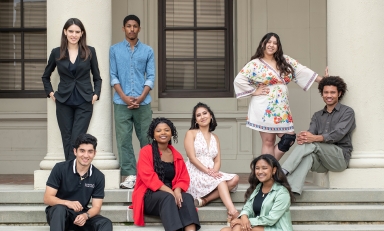
Students in a remote version of the linguistics class create bilingual, publicly facing work that aims to address sociolinguistic justice.
In the Fall of 2018, assistant professor of Spanish & French Studies Mariška Bolyanatz Brown taught the linguistics course “Spanish in the United States” for the first time. Her students were assigned to do mini-fieldwork projects in local neighborhoods, interviewing different Spanish speakers. But Fall 2020, of course, was a different time.
“I needed to reframe this project for a remote semester,” Bolyanatz Brown says, “so I pivoted to using infographics to dispel common myths about Spanish in the U.S. with the goal of advocating for sociolinguistic justice.”
Students researched a chosen topic and worked in small groups to develop infographics that were added to a class website with versions in both English and Spanish. The website was created in collaboration with Yovi Cifuentes and Samantha Alfrey from Oxy’s Center for Digital Liberal Arts.
The projects were meant to deconstruct and debunk commonly held misconceptions about Spanish in the U.S. Examples include the idea that speaking Spanish is a danger to national unity, immigrants today aren’t learning English as quickly as those in the past, “Spanglish” is a distorted form of communication, and most Spanish speakers in the U.S. are immigrants.
At a time when Spanish has been so heavily used as a weapon by politicians to divide the United States, it was really fulfilling to be able to learn about—and participate in—sociolinguistic activism.
-Noah Yee Yick ’22
Junior Clara Sena-Gersh loved learning about the diversity of the Spanish language and Latino community in our country.
“As a heritage speaker from New Mexico it was incredibly validating to be learning about the types of Spanish dialects I use or have grown up with such as Spanglish or New Mexican Spanish,” she says. “These dialects are often looked down upon, but to be able to learn the history and realize that they are still widely used meant a lot.”
Seeing the research work of his classmates come together in the form of infographics that can help dispel myths was very satisfying for junior Noah Yee Yick.
“At a time when Spanish has been so heavily used as a weapon by politicians to divide the United States, it was really fulfilling to be able to learn about—and participate in—sociolinguistic activism,” he says. “Spanish usage is at a tipping point where it could continue to grow or be lost and we must act on this by educating and informing others.”
You can view the student projects via the links below.



